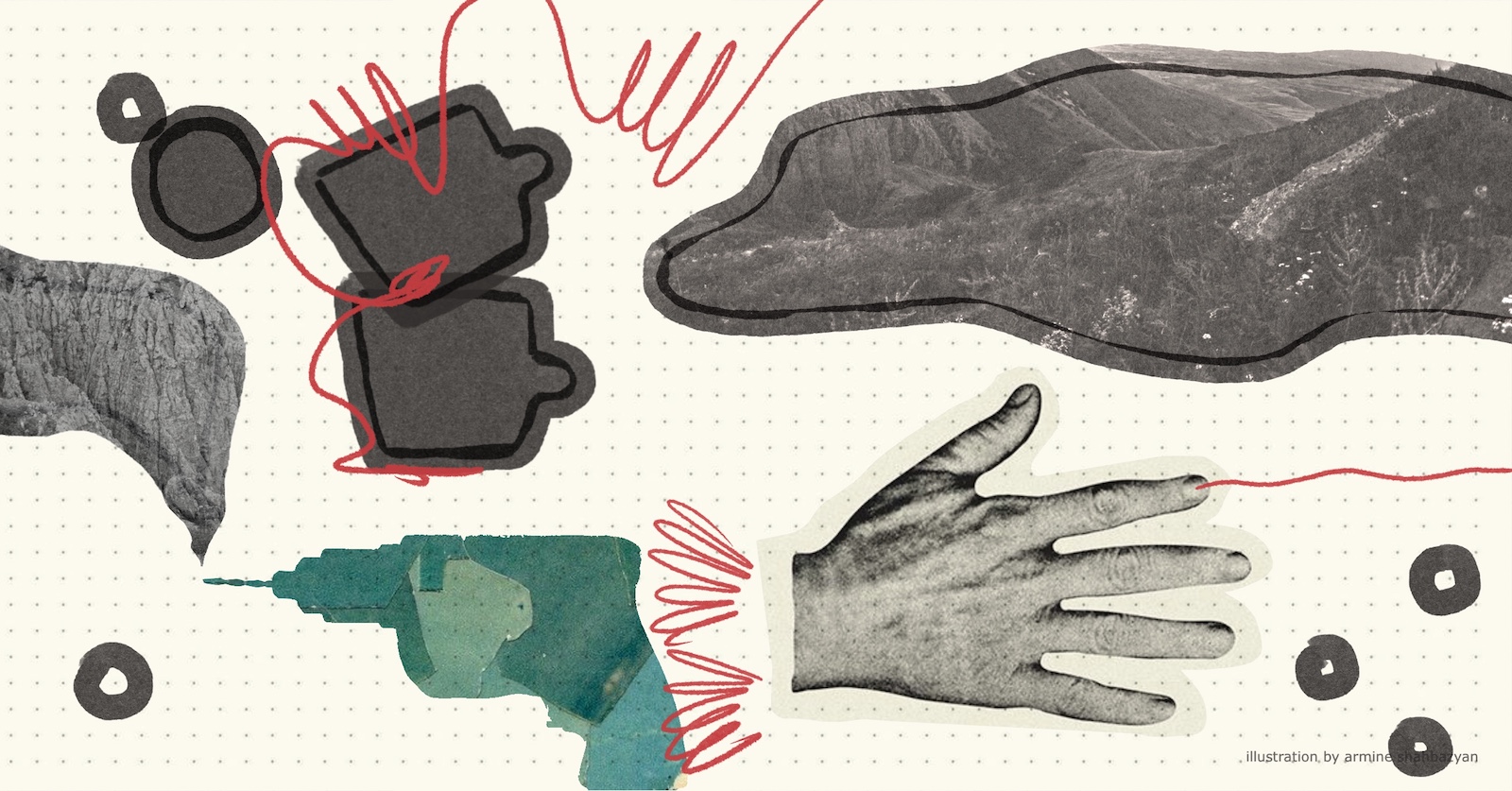
Visiting one post-Soviet state, you can then recognize it in all others – the similar patterns of urban planning and the identical buildings, structures, roads, pipes, wires, tiles, etc. However, an outsider delving inside under the extreme familiarity of the material environment finds an extreme “strangeness” of social interactions and practices. The [Outside In] series is about emplaced paradoxes and nuances. It spotlights the mundane in Armenia’s peripheral locations, where the seemingly unspectacular encounters with people and things allowing us to capture the unique features of the territory.
Outside In
Essay 4
I spent most of 2023 in a small Armenian town doing my ethnographic field research. There, I encountered Zaruhi. As she speaks perfect Russian and was always incredibly supportive of my, mildly put, less-than-perfect Armenian, and because we are nearly the same age, Zaruhi and I often spent time together gossiping over infinite amounts of “bitter” coffee. It was a practice that, I must confess, constituted a significant part of my field research. Exacerbating acid reflux, it also provided me with invaluable information on the everyday life of small-town Armenian women.
Zaruhi, her husband Alik, and their five children, the youngest of whom was just under half a year old when we first met, live in a house typical of Stalin-era architecture “for the masses”. While it is lavishly decorated on the outside, it is a highly uncomfortable dwelling on the inside. The house has tiny rooms, lacks natural gas, which requires gas cylinders for cooking and electric heaters for warmth, and has no hot running water. A lack of funds for significant renovations and the inability to purchase new items mean constant infrastructure-related hardships and breakdowns. Items in the house continually crumble, making repair a mundane practice. According to traditional gendered divisions of household labor, repair work falls to Alik. His ability to perform such work is very much linked to being a “proper” man:
“Alik is a true man. He can fix anything himself. He is not like Gurgen [the neighbor], who always calls Alik when something breaks. Gurgen can’t even screw in the light bulb. What a shame.”
Like other men in the town, Alik is a seasonal construction worker in Russia. He leaves in mid-Spring and returns in late Autumn. During this time, Zaruhi is left to manage the house alone. I naturally wondered how she copes:
“So, what do you do when something breaks, like problems with the wiring, as you had in December?”
“Nothing breaks.”
“But if something does,” I insisted, “do you call a specialist?”
“Oh, no,” Zaruhi looked startled and shocked at my question. “This is shameful.”
“Why?” I suspected what the answer might be, but continued putting on the hat of a naïve foreigner.
“Because I cannot invite another man into the house while my husband is away. What will the neighbors think of me?” she explained in response to my pitiful “ignorance”.
“Yes, right. Sorry. But then what can you do? You don’t have any male relatives living close by.”
“Well, in the worst case, I can call Gurgen [the neighbor]. He’ll come with his wife.”
Yeah, right, I thought to myself –– the Gurgen who was a “shamefully” unhandy man.
The puzzle of repair, however, was soon resolved. That day, I arrived at Zaruhi’s house at our usual coffee time, when the elder children were at school or daycare and the youngest one was having a nap. As usual, I entered freely, and there she was –– I caught Zaruhi at the “crime scene” with a drill in her hand putting back a fallen shelf. She blushed, turning tomato red, while I stood motionless, greetings frozen on my lips. We silently looked at each other for a while, my presence feeling wholly inappropriate. I had interrupted what seemed to be a very intimate moment, as if I had walked in on her not mending the house but having intercourse. Finally, Zaruhi awkwardly smiled and said, “Well, now you know. But please don’t tell anyone. Let it stay between us.” I pointedly nodded, resolving to investigate the situation more carefully later.
Later came sooner than I thought. My neighbor Seda, a Georgian Armenian woman in her mid-fifties, came by that same evening. She lived on the first floor, also in an apartment where “nothing broke” while the husband was away. Upon my opening the door, she complained about a foul odor from the sewerage. Assuming that I had disposed of something in the toilet, she displayed a surprisingly detailed knowledge of the pipe system in our house, as well as of the durability of water filters. After convincing her of my innocence, Seda kindly offered to check the faucet gaskets to eliminate the annoying water leak I mentioned as the sole plumbing problem in my apartment. I could not miss the chance and agreed immediately. A few minutes later, Seda returned, with a fully-fledged toolkit in hand. With graceful and experienced movements, she quickly won the battle against the leak. It felt like I was joining a secret society. A society of a “female fix”, where women “manfully” bypassed traditional gender norms to get things done.
Since that day, I have often noticed women at my field site handling tools and construction materials, displaying that they wielded hammers, pliers, and wrenches as proficiently as they did pans, irons, and mops. It is not uncommon for women to take on traditional “male jobs” in extreme times, like wars. However, the inclination to conceal this reality during peaceful times suggests that it is a source of anxiety and embarrassment.
Life in a small Armenian town is structured between the poles of shame – amot [ամոթ] on the one hand and respect – hargank [հարգանք] on the other. I might humbly presuppose that conforming to gender roles and norms is a big part of acting respectably and being accepted as a “good” member of the community. Men are seen as the “breadwinners” who engage in productive rather than reproductive labor. Repair is a specific kind of care work; however, it might also be regarded as a logical extension of productive labor. What men make or fix around the house has some theoretical market value, which gives the practice of DIY repair an aura of masculine legitimacy. Furthermore, it provides men with direct control of the physical environment of the household. The conventional “female duties” include cooking, cleaning, and care for the family members. In relation to repair, women then would at best limit themselves to helping their husbands and acting as an audience that appreciates their domestic successes. Against this background, the “female fix” might be regarded as demising both man- and womanhood that are tied to the division of household labor with separated and non-overlapping spheres of competence and specific hierarchies of power relations.
“A girl’s gotta do what a girl’s gotta do” goes a famous line from a song by Robert Byrne and Rick Bowles. In the Armenian language, there is a phrase similar to the English expression “(s)he is something” – demk e [դեմք է]. Literally translated it means “(s)he is a face”. Zaruhi, along with other handy women that I have encountered, were definitely demks. They are figures representative of a strong, enduring woman, who routinely undertakes the often-unrecognized (mostly never recognized) and thankless unpaid reproductive labor that, as my small example illustrates, transcends conventional “female duties”. These frequently overlooked endeavors, on the one hand, challenge established household roles and even subvert hierarchies. But, on the other hand, female engagement in repair, albeit in an obscured way, significantly contributes to the opposite. That is, to maintain continuity – the traditional family, the household, as well as the broader lived environment, keeping it recognizable and habitable when within the postsocialist (dis)order, things and relations are disintegrating and falling apart.
See all [Outside In] articles here


